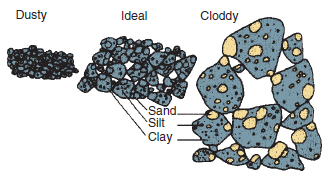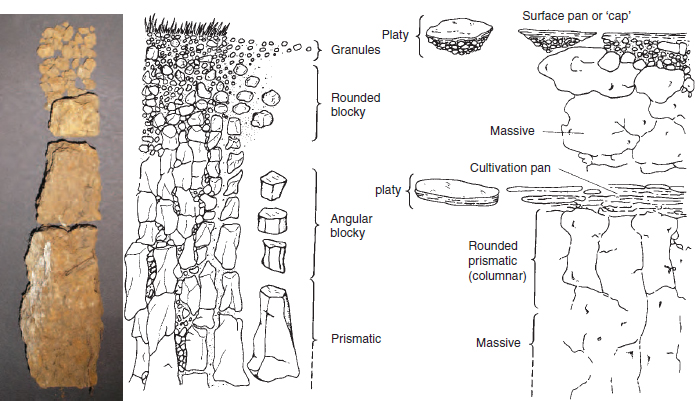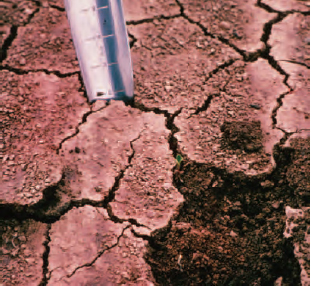Soil structure
ContentIn order to provide a suitable root environment for cultivated plants the soil must be constructed in such a way as to allow good gaseous exchange, whilst holding adequate reserves of available water. There should be a high water infiltration rate, free drainage and an interconnected network of spaces allowing roots to find water and nutrients without hindrance. There should be no large cavities that prevent thorough contact between soil and roots and allow roots to dry out in the seedbed. The soil should be managed so that erosion is minimized. Good structural stability should be maintained so that the structure does not deteriorate and limit crop growth. Porosity The plant roots and soil organisms live in the pores between the solid components of the growing medium. In the same way that a house is mainly judged by the living accommodation created by the bricks, wood, plaster, cement, etc., so a soil is evaluated by examining the spaces created.
Pores greater than about 0.05 mm in diameter, called macropores, can drain easily to allow in air within hours of being saturated (i.e. fully wetted), whereas the smaller pores, micropores continue to contain only water. The roots remove more water from these micropores allowing more air back into the soil (see soil water). Ideally, there should be a mixture of pore sizes allowing good water holding, free drainage, gaseous exchange and thorough root exploration, as shown in Figure 17.12. An important indicator of a satisfactory growing medium is its air-filled porosity or air capacity, i.e. the percentage volume filled with air when it has completed draining, having been saturated with water. Bulk density is the mass of soil per unit volume and it can be measured by taking a core of soil of known volume and weighing it after thorough drying. In normal mineral soils results are usually between 1.0 and 1.6 g/ml. The difference is largely attributable to variation in total pore space. Finer textured soils tend to have more pore space and therefore lower bulk density than sands, but for all soils higher values indicate greater packing or compaction. This information is not only useful to diagnose compaction problems, but can also be used to calculate the weight of soil in a given volume. Assuming a cultivated soil to have a bulk density of 1.0 g/ml, the weight of dry soil in one hectare to a plough depth of 15 cm is 1500 tonnes; when compacted the same volume weighs 2400 tonnes. Similarly, 1 m3 of a typical topsoil with a bulk density of 1.0 will weigh 1 tonne (1000 kg) when dry and up to half as much again when moist. Soil structures The pore space does not depend solely upon the size of the soil particles as shown in Figure 17.8, because they are normally grouped together. These aggregates, or peds, are groups of particles held together by the adhesive properties of clay and humus. The ideal arrangement of small and large pores for establishing plants is illustrated in Figure 17.12 alongside a dusty tilth with too few large pores and a cloddy tilth that has too many large pores. A soil with a simple structure is one in which there is no observable aggregation. If this is because none of the soil particles are joined together, as in sands or loamy sands with low organic matter levels, it is described as single grain structure. Where all the particles are joined with no natural lines of weakness the structure is said to be massive. A weakly developed structure is one in which aggregation is indistinct and the soil, when disturbed, breaks into very few whole aggregates, but a lot of unaggregated material. This tends to occur in loamy sands and sandy loams. Soils with a high clay content form strongly-developed structures in which there are obvious lines of weakness and, when disturbed, aggregates fall away undamaged. The prismatic, angular blocky, round blocky, crumbs and platy structures which are found in soils are illustrated in Figure 17.13. Development of soil structures Soil structure develops as the result of the action on the soil components of natural structure-forming agents , freezing and thawing, wetting and drying, root growth, soil organisms, as well as the influence of cultivation:
In soils with low clay content the roots are vital in maintaining an open structure. The exploring roots probe the soil, opening up channels where the soil is loose enough and producing sideways pressure as they grow. On death, the root leaves behind channels stabilized by its decomposed tissue for other roots to follow. Fine granular structures are developed under pastures by the action of the fibrous rooting over many years. The soil structure is greatly improved by the rootball. Its physical influence is most easily appreciated by shaking out the soil crumbs from around the root of a tuft of well-established grass and comparing them with the structure of soil taken from a nearby bare patch. Freshly exposed land is often referred to as raw; when weathered it becomes mellow. Once mellow , a seedbed is more easily prepared. The weathering process and influence of cultivation tend to produce rounded blocky structures and rounded granules in the cultivated zone. Cultivation of soil by hand or mechanized implements is undertaken to produce a suitable rooting environment for plants, to destroy pests and weeds and to mix in plant residues, manures and fertilizers. However, the use of cultivators can lead to the formation of platy layers or pans, which are characterized by the lack of vertical cracks and form an obstruction to root and water movement. The surface of soils is also compacted to create surface capping by associated traffic, whether by feet or tyres, if undertaken in the wrong conditions (see soil consistency). Natural pans develop in some soils as a result of fine material cementing a layer of soil together. In some sandy soils rich in iron oxide, these oxides cement together a layer of sand where there has been a fluctuating water table, to produce an iron pan. Structural stability Soil aggregates with little or no stability collapse spontaneously as they soak up water, i.e. they slake. Those high in fine sand or silt are particularly vulnerable to slaking. Aggregates with better stability maintain their shape when wetted for a short time, but gradually pieces fall off if left immersed in water. Aggregates with good structural stability are able to resist damage when wet unless vigorously disturbed. Soils with a high level of clay content have better stability than those with low levels. Stability is also increased by the presence of calcium carbonate (chalk), iron oxides, and, most importantly, humus. Tilth The soil surface or seedbed should be carefully managed to produce the required crumb structure.
The fineness of a seedbed should be related to the size of seeds, but ideally consists of granules or crumbs between 0.5 and 5 mm in diameter (see Figure 17.12). Cloddy surfaces lead to poor germination, as well as poor results from soil herbicide treatments. The rain on the soil surface breaks down tilth. As soil crumbs break up, the particles fill in the gaps; this reduces infiltration rates. As the surface dries, a cap or pan is formed (Figure 17.14). Thus fine ‘dusty’ tilths should be avoided and the soil crumbs should be stable so that they can withstand the effect of rain until plants are established. This is particularly important on fine sandy and silty soils, which tend to have poor structural stability. In general, fine tilths should be avoided outdoors until well into spring when conditions are becoming more favourable and growth through any developing cap is rapid. |







